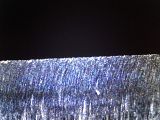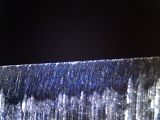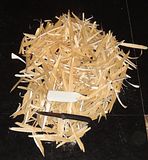
This knife was a rescue from a construction site abandoned by a plaster/painter. It was dirty, extremely dull and the blade had a few small nicks.


This review consists of :
The Chef's knife is a very inexpensive and basic offering. A few specifications :
 As the knife was a rescue and restoration it had to be cleaned up
and then sharpened before it could be used. The edge had a
few small dents
where it appeared to have been used to cut through either very heavy wire
or a small pinner from a finishing nailer. Before the blade was sharpened
these dents were peened back to flat to minimize the metal lost in sharpening.
For a heavy use knife it isn't a good idea to leave weakened metal in the
edge as they can be the source of a tear, but this is a low stress cutting
knife so these little areas would just be sources of burring in sharpening.
As the knife was a rescue and restoration it had to be cleaned up
and then sharpened before it could be used. The edge had a
few small dents
where it appeared to have been used to cut through either very heavy wire
or a small pinner from a finishing nailer. Before the blade was sharpened
these dents were peened back to flat to minimize the metal lost in sharpening.
For a heavy use knife it isn't a good idea to leave weakened metal in the
edge as they can be the source of a tear, but this is a low stress cutting
knife so these little areas would just be sources of burring in sharpening.
 The image at the right shows the edge as sharpened with a 1000 grit
waterstone under 50X magnification :
The image at the right shows the edge as sharpened with a 1000 grit
waterstone under 50X magnification :
 Next on a 3000 grit waterstone, also under 50X magnification :
Next on a 3000 grit waterstone, also under 50X magnification :
 Next on a 8000 grit waterstone, also under 50X magnification :
Next on a 8000 grit waterstone, also under 50X magnification :
This steel X55CrMoV14 this steel is similar a variant of 12C27M, the Sandvik steel very popular in Mora knives and other cutlery where high corrosion resistance is required. The main properties of this steel is that the carbon and chromium are balanced so as to prevent large carbide aggregates and thus after hardening it will achieve a very fine grained martensite matrix (maximum hardness of 60 HRC) with a small amount of very fine carbides on the order of a micron in size. This gives :
Point : the point on the IVO paring knife is inline, very slim and has no issues with scoring, coring, or any type of fine tip work.
Utility : as noted by the initial condition this isn't a rough use utility knife. The edge is extremely thin and while it will do any cutting required, even opening packaging and the like, the edge will deform fairly easy if it is attempted to be used to cut, scrape or otherwise work on very hard materials. The thoughness is however very high and in the case where the edge is overloaded it is just likely to dent to the side and it can be peened back straight.
 However, it should not be inferred that this would not make
an excellent utility knife. Far from it as shown by the
picture on the right. To clarify a list of items cut :
However, it should not be inferred that this would not make
an excellent utility knife. Far from it as shown by the
picture on the right. To clarify a list of items cut :
 As a rough check on edge retention (and durability) the IVO paring knife was
used to break down a piece of pine into a large pile of shavings as noted
on the picture on the right. There was next to no significant effect on the
edge, no rolling, chipping or impaction and the edge still easily sliced
newsprint so it suffered only minor wear.
As a rough check on edge retention (and durability) the IVO paring knife was
used to break down a piece of pine into a large pile of shavings as noted
on the picture on the right. There was next to no significant effect on the
edge, no rolling, chipping or impaction and the edge still easily sliced
newsprint so it suffered only minor wear.
Now it does not make an ideal knife for this type of work because it is only a three finger grip and thus for extended cutting it is a can be a bit abrasive on the ringer finger and the fatigue rate is a bit high because the pinky is dangling off not being used and thus the hand doesn't have proper grip mechanics. Of course it isn't meant to be used in this manner as a replacement for a carving knife.
The purpose of this brief check however was just to make a point. If the knife can do a 1000 slices into seasoned pine without any significant loss of edge sharpness, including cutting through small knots, then how many slices can it do into very soft vegetables, meats, fruits, breads, etc. .
Comfort : The grip is well contoured with a very slight texture. There are no hot spots in use and it in general is comfortable with any grip variation. The only concern is that the working grip area is very small, only three inches inside the front guard and end hook swell. It therefore isn't possible to get a full grip on the handle and most of the work is done with a partial or three finger grip. However the amount of force used in cutting with a paring knife is in general so small that it isn't a significant issue in use.
Security : The only issue is when the handle is covered in grease or oil as the knife does not have a prominent guard and the grip is not heavily textured. Of course paring knives are generally not used for such work, especially when heavy cutting is required so this is not likely to be a functional problem.
Durability : The handle is very resistant to scratches, cuts and general abrasion. It is also very resistant to moisture or heat and would not swell or warp such wood can in extreme cases. The only real concern is extreme heat as if exposed to a burner the handle will melt and then ignite much faster than a wood grip. This produces the curious case that wood doesn't handle moderate heat as well but can take more extreme heat for longer with only light charring.
Cleanup : The synthetic handle does not tend to absorb materials and thus it gets cleaned generally even when rinsing.
In regards to light stress, the IVO paring knife easily handles being left wet and even covered in fruit juices for extended periods of time without rinsing and drying. There is no evidence of corrosion, patina, light mottling or any spotting let alone pitting.
Comments can be emailed to IVO paring knife
Or in the YouTube Playlist.
Most of the pictures in the above are in the
album at PhotoBucket.
| Last updated : | Mon, 20 Feb 2012 21:33:39 Newfoundland Standard Time |
| Originally written: | 11:29:2011 |